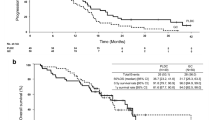Summary
Recent efforts to improve the response rates in advanced ovarian cancer with the use of high-dose cisplatin have been limited by unacceptable toxicity. Based on experimental and clinical studies indicating that reduced glutathione (GSH) is a protective agent against cisplatin-induced toxicity, a new high-dose regimen including GSH as a chemoprotector was designed in an attempt to improve the efficacy and therapeutic index of cisplatin. A total of 40 consecutive patients with stage III (bulky) and IV ovarian carcinoma were treated with cisplatin (40 mg/m2 daily for 4 consecutive days) and cyclophosphamide (600 mg/m2 i. v. on day 4). The treatment was repeated every 3–4 weeks for five courses unless progression or severe toxicity occurred. Before each cisplatin administration, patients received GSH (1,500 mg/m2) i. v. over 15 min, with a standard i. v. hydration (2,000 ml fluid) without diuretics. Debulking surgery was initially attempted in 18 patients and, after 2–3 courses, in 16 patients; it could not be carried out in 6 patients. Three patients were not evaluable for response because they prematurely discontinued their treatment. In all, 23 patients (62%) achieved complete clinical remission (negative second-look laparotomy in 16), with an overall (complete + partial) response rate of 86%; 2 patients achieved disease-free status following second surgery. Nausea/vomiting was the most severe acute toxic effect; myelosup-pression was acceptable. Renal impairment was effectively prevented by GSH. Neurotoxicity that was not associated with motor dysfunction was the most significant cumulative toxicity in patients (24/32) receiving 4–5 courses. The results of this study indicate that the use of GSH is a safe new method for high-dose cisplatin administration. This regimen is well-tolerated and very effective in ovarian cancer patients with bulky disease and warrants further evaluation.
Similar content being viewed by others
References
Abrams J (1986) Present optimal therapy in ovarian cancer. Eur J Cancer Clin Oncol 22:9
Bagley CM, Rudolph RH, Rivkin SE, Yon JL (1985) High-dose cisplatin therapy for cancer for the ovary: neurotoxicity. Ann Intern Med 102:719
Bhuchar UK, Lanzotti VS (1982) High dose cisplatin for lung cancer. Cancer Treat Rep 66:775
Bohm S, Oriana S, Spatti GB, Tognella S, Tedeschi M, Zunino F, Di Re F (1987) A clinical study of reduced glutathione as a protective agent against cisplatin-induced toxicity. In: Nicolini M (ed) Platinum and other metal coor-dination compounds in cancer chemotherapy. Martinus Nijhoff, Boston, p 456
Borch RF, Dedon PC, Montine TJ (1988) Experimental approaches to reducing platinum induced kidney toxicity. In: Hacker MP, Lazo JS, Tritton TR (eds) Organ directed toxicities of anticancer drugs. Martinus Nijhoff, Boston, p 190
Cohen CJ, Goldberg JD, Holland JF, Bruckner HW, Deppe G, Gusberg SB, Wallach RC, Kabakow B, Rodin J (1983) Improved therapy with cisplatin regimens for patients with ovarian carcinoma (FIGO stages III and IV) as measured by surgical endstaging (second-look operation). Am J Obstet Gynecol 145:955
Griffiths CT, Parker LM, Fuller AF (1979) Role of cytoreductive surgical treatment in the management of advanced ovarian cancer. Cancer Treat Rep 63:235
Lambert HE, Berry RJ (1985) High dose cisplatin compared with high dose cyclophosphamide in the management of advanced epithelial ovarian cancer (FIGO stages III and IV): report from the North Thames Cooperative Group. Br Med J 290:889
Legha SS, Dimery IW (1985) High-dose cisplatin administration without hypertonic saline: observation of disabling neurotoxicity. J Clin Oncol 3:1373
Lokich JJ (1980) Phase I study ofcis-diamminedigt-chloroplatinum(II) administered as a constant 5-day infusion. Cancer Treat Rep 64:905
Markman M, Cleary S, Howell SB (1985) Nephrotoxicity of high-dose intracavitary cisplatin with intravenous thiosulfate protection. Eur J Cancer Clin Oncol 21:1015
Meister A (1983) Selective modification of glutathione metabolism. Science 220:472
Oriana S, Bohm S, Spatti GB, Zunino F, Di Re F (1987) A preliminary clinical experience with reduced glutathione as protector against cisplatin toxicity. Tumori 73:337
Ozols RF, Young RC (1984) Chemotherapy of ovarian cancer. Semin Oncol 11:251
Ozols RF, Young RC (1985) High-dose cisplatin therapy in ovarian cancer. Semin Oncol 12:21
Ozols RF, Corden BJ, Jacobs J, Wesley MN, Ostchega Y, Young RC (1984) High dose cisplatin in hypertonic saline. Ann Intern Med 100:19
Penta JS, Muggia FM, Salem PA (1983) Cisplatin in cancer therapy: optimization of treatment regimens and toxicity protection. In: Muggia FM (ed) Cancer chemotherapy. Martinus Nijhoff, The Hague, p 149
Pfeifle CE, Howell SB, Felthouse RD, Woliver TBS, Andrews PA, Markman M, Murphy MP (1985) High-dose cisplatin with sodium thiosulfate protection. J Clin Oncol 3: 237–244, 1985
Thigpen T, Vance R, Lambuth B, Balducci L, Khansur T, Blessing J, McGehee R (1987) Chemotherapy for advanced or recurrent gynecologic cancer. Cancer 60:2104
Vogelzang NJ, Torkelson JL, Kennedy BJ (1985) Hypomagnesemia, renal dysfunction, and Raynaud's phenomenon in patients treated with cisplatin, vinblastine, and bleomycin. Cancer 56:2765
Wendel A, Cikryt P (1980) The level and half-life of glutathione in human plasma. FEBS Lett 120:209
Wils J, Blijham G, Naus A, Belder C, Boschma F, Bron H, Ceelen T, Eekhout A, Erp JV, Geelen P, Geuns HV, Haest J, Hoogland H, Huiskes J, de Koning Grans H, Kornman J, Kruyver G, Lalisang F, Meulen JVD, Moorman P, de Pree N, Stoot J, Tushuizen P, Vreeswijk J, Wals J, Wetzels L, Willebrand D (1986) Primary or delayed debulking surgery and chemotherapy consisting of cisplatin, doxorubicin, and cyclophosphamide in stage III–IV epithelial ovarian carcinoma. J Clin Oncol 4:1068
Zunino F, Tofanetti O, Besati A, Cavalletti E, Savi G (1983) Protective effect of reduced glutathione againstcis-dichlorodiammineplatinum(II)-induced nephrotoxicity and lethal toxicity. Tumori 69:105
Zunino F, Pratesi G, Micheloni A, Cavalletti E, Sala F, Tofanetti O (1989) Protective effect of reduced glutathione against cisplatin-induced renal and systemic toxicity and its influence on the therapeutic activity of the antitumor drug. Chem Biol Interact (in press)
Author information
Authors and Affiliations
Rights and permissions
About this article
Cite this article
Di Re, F., Bohm, S., Oriana, S. et al. Efficacy and safety of high-dose cisplatin and cyclophosphamide with glutathione protection in the treatment of bulky advanced epithelial ovarian cancer. Cancer Chemother. Pharmacol. 25, 355–360 (1990). https://doi.org/10.1007/BF00686237
Received:
Accepted:
Issue Date:
DOI: https://doi.org/10.1007/BF00686237




